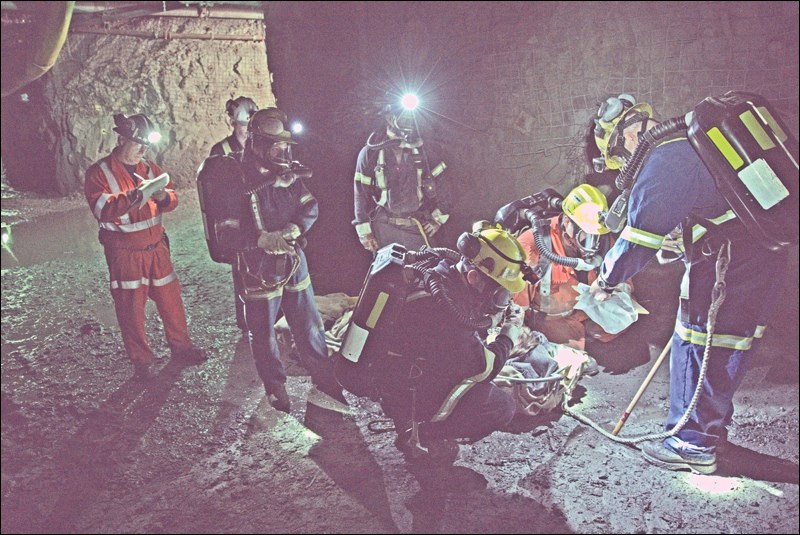It’s the phone call no mine worker looks forward to, that early morning shout from the Shifter advising of an incident below surface – a fire, a rock fall or an explosion – where lives hang in the balance.
Although they too dread the call, there is one small group of dedicated individuals who train tirelessly to respond to it: the Mine Rescue Team.
On the morning of Saturday, May 7 the fear-inducing plea came and three teams of elite rescue personnel sprang into a coordinated response.
While it was only an exercise and no lives were put in harm’s way, these teams competed as if there were, and they performed admirably.
The drill in question was a local competition that the Lalor Mine Health and Safety Department has put on for the second year running. The three teams competing in this year’s exercise did so consecutively, just like they do at the Provincial Mine Rescue Competition. The winner on this day will be rewarded with the right to go on to that event and represent the Lalor Mine.
The competition involved a written test (20 min), bench test of their equipment (40 min), a first aid response (30 min) and the underground rescue.
The underground problem was progressive in nature. Each team was given an hour and 10 minutes to react to the situation, and the next team down was told what they had done and where they had ended up in the scenario. This ensuing team started from there. Judges were watching for teams to stick closely to procedures, while doing the required testing and checks.
There were a number of rescuers in the day’s encounter who have never been tested in competition. During his morning address, Clint Parsons, health and safety supervisor for Lalor Mine, said the event would be used as a teaching and learning experience. In a regular competition, if a coach stepped in or redirected, the team would be penalized.
The Lalor competition was set up somewhat differently than most.
Although the provincial event tests action and reaction, the scoring is based on a demerit system, where teams are judged on what they do wrong, with negative points, or demerits, assessed when they make a mistake on their assignments. With that system, the team with the lowest score at the end of the event is declared the winner.
This one had everyone start at 0 and merit points were dispersed throughout the competition. Parsons said that the only time a team would get demerits would be if they put their team in danger.
While one team did their written test covering mine rescue procedures, respiratory protective equipment, firefighting procedures and first aid, another was underground.
I watched in the background as a team was put through a bench test. To ensure team members could prepare their breathing apparatuses for use and make certain that they were ready when needed. Each member carried close to 50 lbs of equipment on their backs and belts.
This particular check had a little extra thrown into it. Judges Gerald de la Roche and Renae Campbell loosened a connection on one of the units and each team was expected to pick up on it. During this test, #1 Team Captain Bob Forsyth found it on his pack.
From there, it was over to the main office for a briefing by the event’s director of operations, Tony Butt. He briefed teams before they took on the underground rescue mission.
As soon as team the entered the room, Butt got directly to the point.
“At 8:15 this morning, workers on 910–metre level reported smoke coming up the main ramp and called for the release of stench gas,” Butt said with purpose. “It was released at 8:18 am. At that point there were 38 people tagged in underground. All but two have been accounted for. The two missing are systems operator Joe Dirt, whose task for the day was to go to 955–metre level conveyor system and clean up an ore spill underneath the chute. The second missing is industrial mechanic Jack Wrench, who was to go to the 955–metre level pump station to do PMs [periodical maintenance] and monitor water levels in sumps. No word from either. The 36 other people are sealed in various refuge stations throughout the mine. Ventilation systems are performing normally. Pumps are running. Cameras at the 955–metre level chute are not working. The prime directive is the safety of the team, then look for the two missing workers and the source of the smoke.”
Under questioning, Butt further related that the first team down encountered thick black smoke as they accessed the level and got as far as the refuge station, where they roped off the drift. They took a fire hose with them. They didn’t find the missing workers and eventually returned to the station and from there to surface, the sprinkler system engaging as they retreated.
Geared up and under air, #2 Team captain Terry Hornyak led his charges into the cage and from there into the unknown of the underground scenario.
Shortly after leaving the cage on the 955 m level, the team entered the drift and were accosted by thick, black smoke. This was simulated by placing small black garbage bags over team members’ heads before they made their way to the point where #1 Team left off.
It is a precarious journey, to say the least. They tethered themselves to the stretcher, and to each other if they needed to stray from it in order to rope off an area already checked.
After checking out a personnel carrier in the drift and an electrical substation, they made their way further down the haulage and heard a faint voice responding to their calls.
They found one of the missing men and, after administering an air pack and immediate first aid, loaded him on the stretcher, whisking him back down the drift, to the cage, and up to surface.
Finished within the allotted time, the team headed for the showers then over to the rescue trailer for lunch.
I quickly moved over to see #1 Team captain Bob Forsyth lead his group into the first aid problem.
They were all in motion as soon as they walked through the door of the Lalor warehouse. Inside they found a man on the warehouse floor with a crate resting on his legs.
The victim was a 54-year-old warehouse worker with a history of angina, unconscious, with shallow breathing, legs pinned and suspected broken, and a possible spinal injury.
Forsyth immediately called the ambulance, then asked his team to place two aspirins under the man’s tongue. One steadied his head, one administered oxygen and a C (cervical) collar, while the other two went to work with pneumatic lifts raising the large crated hydraulic ram that had fallen and pinned his legs.
They lost him once during the scenario and administered cardiopulmonary resuscitation (CPR) and then an automated external defibrillator (AED) to resuscitate him. They freed the worker, placed him on a backboard and moved him to the ambulance before time was called.
With the day wrapping up, the teams loitered around the Lalor yard as the judges huddled inside, going over their scoring sheets.
The winning team was announced at that night’s awards ceremony. It was the #3 Team consisting of captain Aldon Kowalchuk, second Riley Eastman, third Jeremy Nickel, fourth Jeremy Campbell, and vice-captain Jon Young.
They will represent Lalor Mine at the Provincial Mine Rescue Competition, which will be held at Thompson’s Birch Tree Mine on Thursday and Friday, May 27 and 28.




